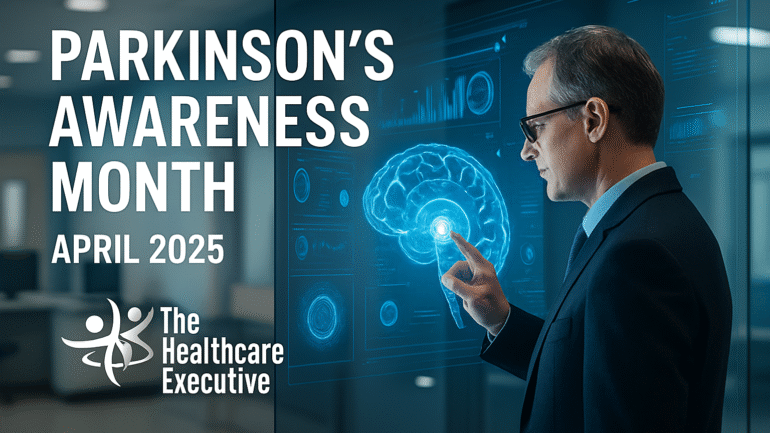Parkinson’s Awareness Month – April 2025

- Posted by Greg Wahlstrom, MBA, HCM
- Posted in Health Observance Calendar
Understanding, Supporting, and Advancing Parkinson’s Care
Published: April 18, 2025
Parkinson’s Awareness Month in April 2025 serves as a national call to action to improve understanding, early diagnosis, and long-term care for individuals affected by Parkinson’s disease. Parkinson’s is a progressive neurological disorder that impacts motor function and quality of life, affecting over 10 million people worldwide. According to the Parkinson’s Foundation, awareness and education remain critical in addressing misdiagnosis and access to care. Healthcare providers are encouraged to expand community education and screening efforts to detect symptoms such as tremors, muscle rigidity, and gait disturbances early. Institutions like the Jefferson Health Movement Disorder Center have become models for early detection programs integrated with neurology, primary care, and behavioral health. By investing in earlier interventions, outcomes for patients and caregivers improve significantly.
Comprehensive care for Parkinson’s requires a coordinated, interdisciplinary approach. Patients often benefit from collaboration between neurologists, occupational therapists, speech-language pathologists, and physical therapists. Health systems like University of Rochester Medical Center are advancing team-based care models tailored to each stage of the disease. Moreover, hospitals can improve access by embedding Parkinson’s-specific services into outpatient rehabilitation and telehealth programs. The Parkinson’s UK Support Hub recommends routine assessment of care partners, as caregiver burnout often leads to hospitalizations and institutionalization. Equipping clinical teams to support both the patient and the family is a crucial part of value-based Parkinson’s management.
Technology is playing a transformative role in how Parkinson’s is diagnosed, treated, and monitored. Wearable devices and AI-powered analytics are increasingly used to track tremor frequency, medication adherence, and motor symptom progression. The Cleveland Clinic’s Lou Ruvo Center for Brain Health integrates remote monitoring with personalized medication titration to reduce side effects and delays in symptom control. Additionally, telemedicine platforms are expanding access to neurologists in rural communities, decreasing time to diagnosis and intervention. Health executives must invest in tech-enabled solutions that bridge access gaps and empower patients with Parkinson’s to maintain independence longer. Continued investment in clinical trials and real-world data capture is also essential for long-term progress.
Workforce training in Parkinson’s care remains an urgent need, especially in aging populations. The Parkinson’s Disease Society of the United States emphasizes the importance of competency-based training for primary care providers, nurses, and allied health professionals. Hospitals can implement annual continuing education through partnerships with accredited training providers and organizations like the Michael J. Fox Foundation. An example is Johns Hopkins Medicine, which offers specialized Parkinson’s training programs embedded into their neurology residency tracks. Educating frontline teams not only improves patient care but fosters empathy and helps reduce stigma. Interprofessional education must be prioritized in strategic workforce development initiatives.
Parkinson’s Awareness Month is a critical time to renew public and institutional commitment to advancing neurological care. Leaders in hospital administration and executive roles should integrate Parkinson’s strategy into broader neurodegenerative disease initiatives and aging health system plans. Preventative models, such as early-stage interventions and proactive screening, can be supported through CMS quality programs and community health needs assessments. Aligning with organizations such as the American Parkinson Disease Association offers access to strategic partnerships and patient education materials that health systems can deploy locally. As we observe this important month, it’s clear that improved outcomes require awareness, innovation, and executive alignment across the continuum of care.
Discover More:
To explore executive insights on strategic workforce planning, view our blog post “The Healthcare Workforce Crisis: Executive Solutions That Actually Work”.
Internal Links
- The Healthcare Workforce Crisis: Executive Solutions That Actually Work
- Green Hospitals: Leading the Way in Climate-Conscious Healthcare
- Rebuilding Trust in U.S. Healthcare: A Leadership Blueprint



